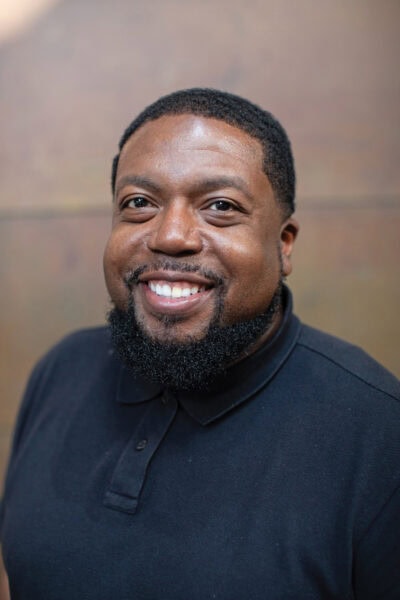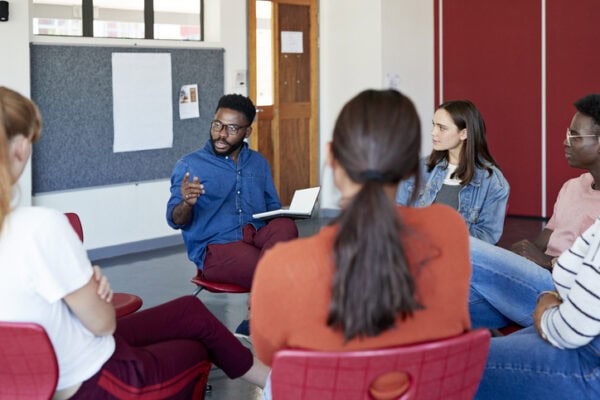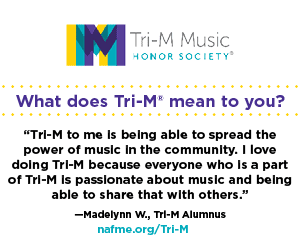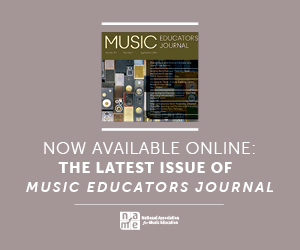/ News Posts / Music Education: A Place in Space
Music Education
A Place in Space
By NAfME Member Adrian Davis
This article first appeared in the January 2025 issue of Teaching Music.
Self-reflection can help us create a philosophy of music education that welcomes all cultures into the music classroom.
Teaching music can feel complicated sometimes. I can be my own worst critic, internalizing every little detail of what I do even before the ideas are presented in person. Others may experience the same feeling when attempting to strategize to accomplish musical tasks while connecting with our student audiences. The process often leaves us overthinking, feeling out of touch, or maybe missing the mark. With all these racing thoughts, I am comforted in knowing that no one owns the sole patent to music education, and no one has all the answers.
One thing on which most educators can agree is that our work must first prioritize students. In the pursuit of being an effective classroom leader, the music classroom can be actualized as more than a space—it should be a place. Using self-reflection, consider not only your values, goals, and philosophies but also your own behaviors to ensure a place in space that is relevant, meaningful, and psychologically safe for all students.
My classroom experiences have taught me that if you do not situate yourself in culture, you could be creating a culture of exclusion.
Philosophy Evolution
At some point in the educational journey of many teachers, one of the challenging tasks was to write a philosophy of music education. Questions that had to be answered included: Who should teach? Who should be taught? Why study music? Who should learn? How should it be taught? Have we stayed the same in our thinking or have our philosophies evolved over the years? Of course, as we gain more experience as educators, our philosophies will, and should, change.
My philosophy has changed from being rooted in a concept of excellence that only values music for music’s sake to now considering a greater connection, influence, and impact that music has on culture, by which I mean a system of beliefs and customs a society or community actively uses to survive and peacefully coexist.
As I have evolved philosophically into an educator who utilizes music as an agent of social change, my classroom experiences have taught me that if you do not situate yourself in culture, you could be creating a culture of exclusion. If the very personal nature of culture is trivialized in the music classroom, it can cause offense to an entire community, leading students to feel like the time for learning is unproductive and the space for learning is unsafe.
From Space to Place
Music education and music performance engage with space literally and metaphorically beyond just musical concepts. Space is also an important concept for learner needs, assessment on many levels, accessible and equitable opportunities, and many other facets of education.
When community and social connections are to be made, the term safe space is often used. In the book Space and Place: The Perspective of Experience (1977), however, Yi-Fu Tuan describes space as a location that has no social connections with a person. A space is irrelevant, abstract, and unsubstantial.
How, then, can we call a space “safe”? Is it because you said it was safe? Consider that the other human beings who inhabit the classroom space throughout the day do not necessarily see, feel, or hear music or life the same way you do.
Tuan also differentiates space from place. He describes place as a location created by and through human experiences—a space filled with meaning. Earth is a place. School is a place. The curriculum and pedagogy of your classroom can and should be meaningful for all students, based on the quality and attributes that occupy the space in your classroom place.
New music educators often have wide eyes and grand aspirations when entering the profession. Many have dreams of taking on the world and building an outstanding music program based on model programs they experienced in high school or college. But what did school teach you? What did it not teach you? For more experienced educators, what have you built in your space that is based on learning and experiences both in and out of school?
Could you be building fences in or around that space? Fences are barriers or structures constructed to mark a boundary, control access, or prevent escape. In the 2016 film Fences, adapted from a 1985 play by August Wilson, the main character, played by Denzel Washington, offers a clear perspective on the intent of a fence: “Some people build fences to keep people out, and other people build fences to keep people in.”
An argument can be made that systemically oppressive forces may be the foundation of fences built in music classrooms. Some observers, for example, have expressed that certain people of color are deficient in piano and music theory skills, making them to blame for lack of opportunities in music education. In this case, personal biases and thought patterns, or triggers, could be the foundation on which fences are built in the classroom space, and those fences are what could be negatively triggering our learners. Much of our energy is put into evaluating how our students are behaving, while the question we should be asking is, “How am I, the teacher, behaving?”
Awareness of Triggers and Behaviors
Most teachers can think of something that negatively triggers them in the classroom. I can use myself as an example. Every so often, there are certain non-verbal behaviors of students in an instrumental or choral ensemble that may trigger me. In the past, some of my reactions were to begin speaking with a louder voice, or to become more abrupt in my body language and verbal communication. My students could sense my frustration.
At the same time, my behavior was creating tension in the classroom. I could sense some of my students shutting down. After some rehearsals and classes where I began to feel both physically and emotionally drained, I decided to video record myself during class and focus on observing my own behavior, not student behavior.
I recorded myself in class daily for two weeks. During this time, I did a lot of self-reflection, examining and seeking to understand why I think, feel, and do things a certain way. This self-assessment also meant unpacking my personal strengths, areas for growth, values, beliefs, and emotions. Seeing myself allowed me to realize that many of my actions and reactions to triggers were leading to oppressive, culturally irrelevant behaviors.
I saw students not learning because I was more interested in compliance than in understanding and engaging with the cultures represented in the space. I saw that I was behaving irresponsibly, as I am supposed to be a role model for students. I also saw a lack of respect for my students’ intelligence. This lack of respect can lead to prejudice, discrimination, racism, sexism, and a professional space of cultural irrelevance. As I reflected further, I realized that I need to be more aware of my triggers so that my behaviors and responses foster a safer, more equitable, and community-relevant place.
Start First with Yourself
As you continue to evolve as an educator of music while building your places of community, always remember to start with yourself first. You cannot change what is going on around you until you change what is going on within you. Getting back in touch with your core self and becoming aware of how your beliefs and lived experiences have impacted you are the initial steps to becoming an effective classroom leader. Those initial steps are also essential for turning your music classroom from an abstract space with limited to no social meaning into a more dynamic, culturally pluralistic, and socially relevant place.
About the author:
 NAfME National Executive Board member and NAfME Equity Committee member Adrian Davis is the Performing Arts Coordinator for Saint Paul Public Schools, an Assistant Professor of Music Education at the University of Minnesota, and President of the Minnesota Music Educators Association (MMEA).
NAfME National Executive Board member and NAfME Equity Committee member Adrian Davis is the Performing Arts Coordinator for Saint Paul Public Schools, an Assistant Professor of Music Education at the University of Minnesota, and President of the Minnesota Music Educators Association (MMEA).
Interested in reprinting this article? Please review the reprint guidelines.
The National Association for Music Education (NAfME) provides a number of forums for the sharing of information and opinion, including blogs and postings on our website, articles and columns in our magazines and journals, and postings to our Amplify member portal. Unless specifically noted, the views expressed in these media do not necessarily represent the policy or views of the Association, its officers, or its employees.
Published Date
March 20, 2025
Category
- Class
- Culture
- Diversity, Equity, Inclusion, and Access (DEIA)
- Gender
- Race
- Representation
- Sexuality
- Social Economic Status
Copyright
March 20, 2025. © National Association for Music Education (NAfME.org)





